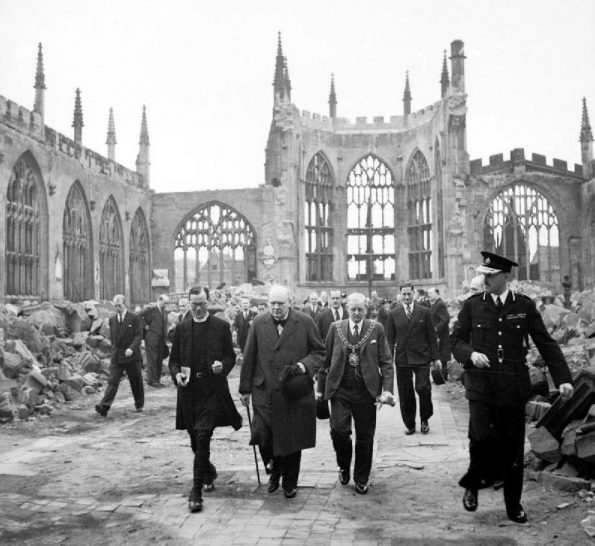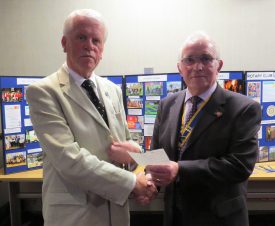Warwick Rotary had over 70 people for dinner as Rotarians from neighbouring clubs, Southam, Shipston and Leamington, and guests, joined them to hear about the night of 14th November 1940, 79 years ago, when the medieval centre of Coventry was razed to the ground by enemy bombing.
Mike Bunn of the Friends of Coventry Cathedral presented a detailed account of that night in a presentation “have you seen any flares tonight” using personal accounts from the firefighters of surrounding towns who came to help, and archive photographs. The city was unprepared for the raid and on the night received no prior warning of the Luftwaffe attack. Equipment was inadequate and resources could not get into the city as water quickly became unavailable and collapsing buildings prevented access.
More than 500 German bombers took part in the overnight raid on Coventry in a bid to destroy it’s factories churning out the machines of war- including Vickers Armstrong, Hawker Siddeley and Rolls Royce. Hundreds of people died as high explosives and 30,000 incendiaries obliterated the face of the medieval city, including the majestic cathedral of St Michael. Dozens of magnesium incendiaries landed on its wooden roof and despite the efforts of the fire wardens, without sufficient water the cathedral was doomed.
The firebombing left the city centre in ruins with only the spire and shell of the cathedral surviving. About 568 were killed with thousands left homeless, 4,000 houses were destroyed, and three quarters of the manufacturing premises. 100,000 Coventry folk abandoned the city on foot that night as the fire took hold. The flames could be seen from Rugby and Birmingham as it was a clear moonlit night, ideal for the raid which Hitler had called in retaliation for the bombing of Munich earlier that month. One guest living in Barford recalled seeing the glow in the sky and helped re-home evacuees there. At the time all people were told was that a “Midlands city” had been badly damaged.
The raid on Coventry was the most concentrated air raid of the Second World War and the term “Coventrated” was later used to describe similar levels of destruction on other towns and cities. Churchill and the King visited the ruins of the city to see the devastation.
After the war Coventry worked hard to build a city of peace. It first twinned with Stalingrad, in Russia, then later with Dresden, in Germany, two cities which also know the horrors of war, and the new Coventry Cathedral, built alongside the ruins of its predecessor, is a world centre for reconciliation.
Amongst the audience was a lady whose father had been an ARP Air Raid Precaution officer actually on the cathedral roof during the raid and showed the audience a cartoon sketch of her father and hose pipe. She was encouraged to show this to the Friends of Cathedral who have an exhibition of memorabilia of that night.
Thanking Mike Bunn for his fascinating talk President David Brain presented him with a cheque for the “Friends” work of conservation.


